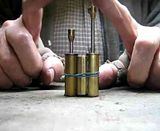Tony Bird
Senior Member
Hi,
I mostly make and play with 16MM Scale model steam locomotives that run on garden railways. Most of my stock is scratch built but very occasionally I buy some thing to play with. This happened at this years 16MM NGM AGM I bought a Mamod locomotive and two carriages. The locomotive and on of the carriages was modified into a 'stand off' scale model of a Lagos Steam Tramway locomotive.
As the remaining carriage was rusting under its paint work it was intended to repaint it to match the Lagos tram's carriage. The carriage was taken apart by drilling out 30 + 'pop' rivets and after removing the paint it was decided to try and make the carriage into a locomotive. To allow the carriage to be taken apart during construction shouldered nuts were soldered into the 'pop' rivet holes. The carriage ends and sides were cut away. The assembled carriage body was painted and lining tape applied.
Thoughts were given to a suitable boiler and it was found that one of the boilers made for a model boat could be shoe horned into the carriage body. The construction of these boilers was described in the Boiler Section titled 'Simple boilers'.
With the boiler fitted within the carriage now tram body thoughts were given to how and where an engine could be fitted. This will be described in my next post.
Regards Tony.











I mostly make and play with 16MM Scale model steam locomotives that run on garden railways. Most of my stock is scratch built but very occasionally I buy some thing to play with. This happened at this years 16MM NGM AGM I bought a Mamod locomotive and two carriages. The locomotive and on of the carriages was modified into a 'stand off' scale model of a Lagos Steam Tramway locomotive.
As the remaining carriage was rusting under its paint work it was intended to repaint it to match the Lagos tram's carriage. The carriage was taken apart by drilling out 30 + 'pop' rivets and after removing the paint it was decided to try and make the carriage into a locomotive. To allow the carriage to be taken apart during construction shouldered nuts were soldered into the 'pop' rivet holes. The carriage ends and sides were cut away. The assembled carriage body was painted and lining tape applied.
Thoughts were given to a suitable boiler and it was found that one of the boilers made for a model boat could be shoe horned into the carriage body. The construction of these boilers was described in the Boiler Section titled 'Simple boilers'.
With the boiler fitted within the carriage now tram body thoughts were given to how and where an engine could be fitted. This will be described in my next post.
Regards Tony.

























































